
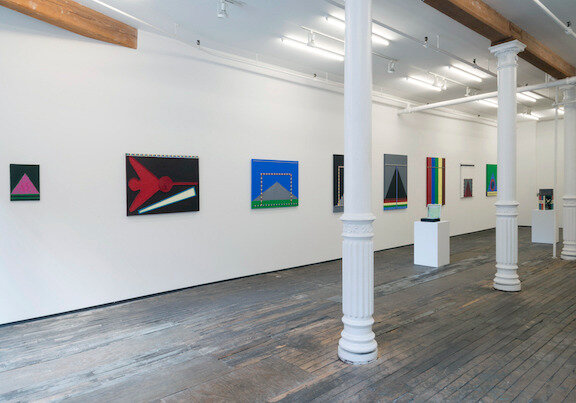
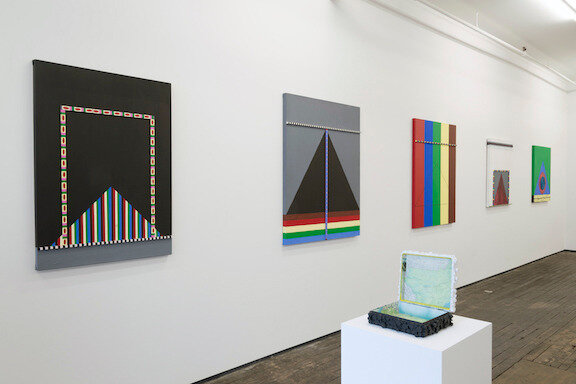
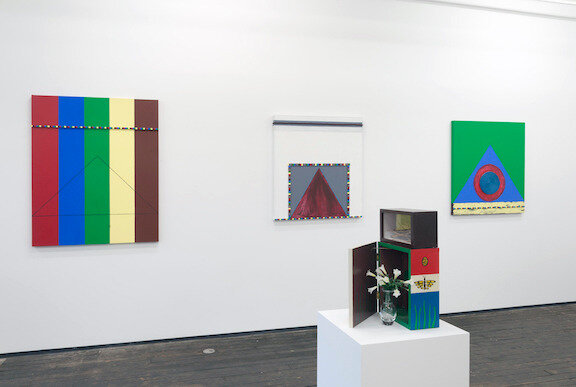
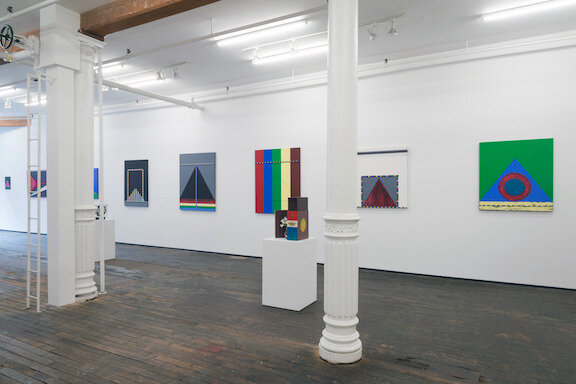
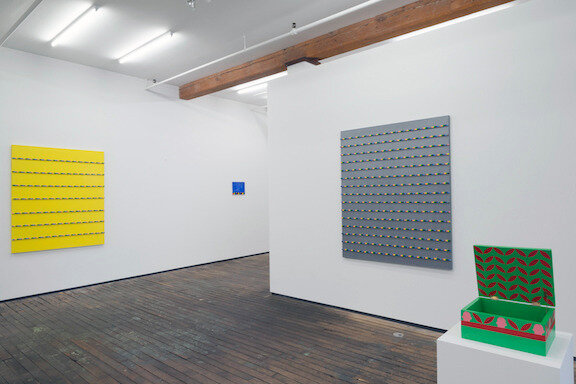
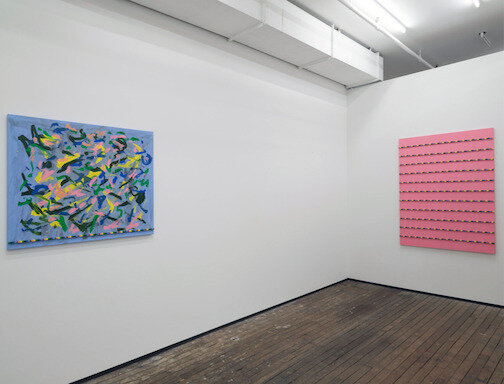
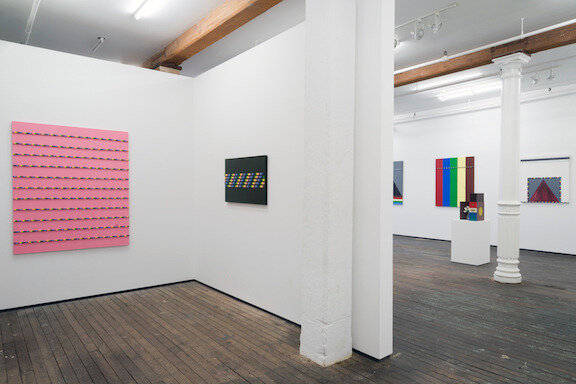
NEW YORK
Regina Bogat: Works from the 70s and 80s
October 7 - November 28, 2015
Exhibition Catalog Available, please check out our Books page for more information.
Zürcher Gallery is pleased to continue re-discovering the work of Regina Bogat (born 1928, Brooklyn, NY). Bogat’s first solo show at Zürcher Gallery, The New York Years 1960-1970, was held in autumn 2013. This third exhibit continues the retrospective, focusing on paintings, paper works, sculptures and objects from 1971 through 1987. Ahead of its time, Bogat’s work resonates with the work of young artists today.
Regina Bogat set up her studio in Chelsea in 1948 and, in 1959, at 222 Bowery. She mingled with other artists frequenting the10th Street galleries, the Artists Club and the Cedar Bar, becoming close with many leaders of the New York School: Elaine de Kooning, Ad Reinhardt, Eva Hesse, Donald Judd, Sam Francis, Mark Rothko, who had his studio at 222 Bowery across the hall from hers, and Alfred Jensen, whom she married in 1963. Certainly their peer in artistic skill, knowledge, life work and originality, the rampant sexism of the time left Bogat largely unrecognized. Zürcher Gallery is thrilled to take the lead in correcting that injustice!
Regina Bogat shared Eva Hesse’s inventiveness in utilizing unconventional materials in her paintings and objects, working with wooden strips, dowels, and other versatile materials like Sculp-metal. She took the step of “materializing” separations between colored planes, placing them in relief with segments of wood glued to canvas. In the late 1960s, she became more interested in pushing these separations toward bending space on the visual plane. She exercised constant pressure through repeating colored sections (a minimalist trait), and through the breaking points of lines. She achieved a similar effect in other pieces by limiting the use of color only to the strips of wood glued to canvas. In the 1970s, a new stage was reached when Bogat introduced nylon rope, thread, cord and enamel to her extensive list of materials. Untitled 1971 was shown in the seminal exhibit, Women Choose Women, curated by Lucy Lippard (New York Cultural Center, 1973). Bogat continued to study line through her use of these new materials, and found the “rigid” and “hard-edged” qualities of her wooden strips replaced by the “fluid” and “flexible” traits of the rope and thread. Furthermore, by pushing these fabric lines through the works’ surface, rather than gluing them onto the works’ surface, Bogat began to confront the notions of inside vs. outside. In this way, her Threaded Pieces are reminiscent of Hesse’s Ennead (1966), with the major difference being Bogat’s trademark use of bright multicolor. However, what truly ties these works together is the reference to a kind of “feminine work”– the weaving, the sewing – as well as strong sexual connotations; in works like Cord Paintings 14 & 15 (1977), these traits take on a monumental scale.
The Phoenix and the Mountain series (1980) came out of a hard period when Bogat’s husband, Alfred Jensen, was sick and dying. Bogat knew her life was about to change. The Phoenix and the Mountain is a personal metaphor crafted out of mythological and religious elements. The Nazca Lines Bogat flew over when she traveled to Peru (1977), also provided inspiration. At this time, Bogat’s readings about the philosophy of the Tao and early Tibetan Buddhism influenced her interest in Chinese sacred mountains to which pilgrimages are made. The Phoenix, a Greek mythological bird, bursts into flames to be reborn from its ashes. Artistically, The Phoenix and the Mountain was a new iteration of the paintings Bogat made in the 60’s. Here the frame of sticks creates a perspective on the mountain and, specifically, the journey towards the mountain; as the series progresses, the window created by the sticks gets larger or disappears.
Shortly after Jensen’s death (1981), Bogat made Memorial Boxes to contain objects Jensen collected. An admirer of Joseph Cornell’s boxes, Bogat had made boxes in the sixties. She was also inspired by beautifully painted canopic chests she had seen in Egypt.
In the mid-eighties, Bogat produced a series of striking monochromatic paintings with painted sticks attached to them, including Five on Blue, Seven on Yellow, Eleven on Pink, and Fifteen on Silver. These paintings show that a simple, monochromatic canvas with the addition of a number of evenly placed sticks, painted in a colorful pattern, can produce rhythm, movement and light. The stick painting series of the mid-eighties is about simple yet changing structures and very much about the impact of color. As in the cord paintings, the placement of the color and patterns on the sticks is both systematic and playful.There is a group of colors used on the sticks and there is a group of colors used in the cords. The impulse is similar, the materials are different.
During the 70’s and 80’s, Regina Bogat was not afraid of profound change in her work. Her work of this period is entirely original. Bogat’s open-mindedness, curiosity, use of systems and playfulness is consistent throughout her oeuvre.
Bogat has exhibited across the United States and in Europe. Her work is included in prominent collections. In 2014, the Blanton Museum (Austin, Texas) acquired a major work, Cord Painting 14, 1977. In 2015, Regina Bogat was shown by Zürcher Gallery in a solo show at Frieze New York (Spotlight Section curated by Adriano Pedrosa). Zürcher Gallery was one of the 5 shortlisted galleries highly commended for its presentation of Bogat’s work for the Pommery Stand Prize at Frieze NY. In the Summer 2015, Regina Bogat was invited by Sarah Cain to be part of her solo SARAH CAIN Blue in your Body, Red when it hits the Air at the Museum of Contemporary Art, San Diego, CA.
